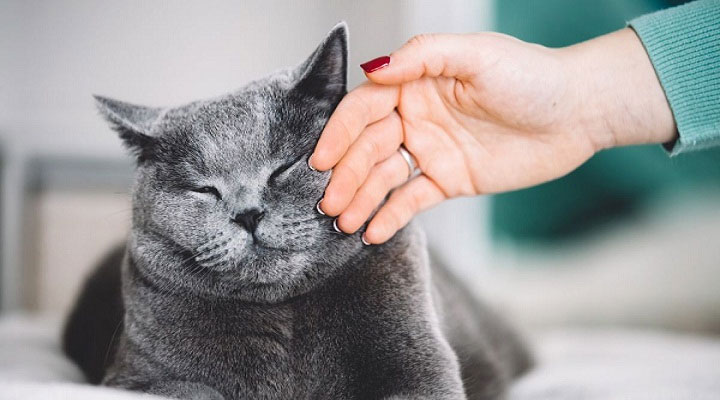Did you know how to caress cats properly?
Many of us have been bitten or scratched by friendly cats while stroking them, even though a minute ago they were enjoying that "happiness". We must be angry about that absurdity, but they actually do it because we haven't stroked properly.
To understand why this happens, we first need to learn a little about the ancestors of cats. The ancestors of domestic cats (African wild cats) are merely used by humans to control pests, but modern cats today are regarded as companions or even loved as children. me
The change in the relationship between humans and cats is thought to have occurred about 4,000 years ago - a little later than dogs. Although this period seems long enough for an animal to adjust to the increasing needs of society, it is unlikely for cats. Domestic cats carry their ancestral genetic characteristics, meaning that their brains still have thought nerves like a wild cat.

Most of us see the faces of very cute cats.
Wild cats live solitary lives and spend considerable time in indirect communication just to avoid having to see each other. Human beings, on the other hand, are a social species, prone to intimacy and touch while expressing affection. We also have large eyes and foreheads, small noses and cat-like faces. This is why most of us see the faces of very cute cats.
So it is not surprising that our initial reaction to seeing a cat or kitten is to caress, cuddle and smile at them. And it's no surprise that many cats can feel this kind of interaction a bit too much.
Cat's emotions
Although many cats like to be caressed, the way they interact is what they have to learn to enjoy in their relatively short time of sensitivity, between two and seven weeks of age.
When it comes to interaction between humans and cats, human characteristics are also important . Our personality, gender, the areas of cats we touch and how to carry cats, all play an important role in the way cats react to our emotions.

An obedient cat is not really a happy cat.
While some cats can react strongly when touched by the body, others can only tolerate our social advances in exchange for good things (food and shelter). It shows that a docile cat is not really a happy cat . Cats that suffer have higher stress levels than those that actively show their "resistance" when stroked.
How to caress cats
The key is to give your cat as many choices and controls as possible during the interaction. For example, we should know if they want to be caressed, where to touch and how long to touch.
Because human nature likes to be exposed to the body and love cute things, this method may not be our instinct. And it will require a little restraint. If we suffer, everything will be rewarded, because research shows that interactions with cats are likely to last longer when the cat actively does it.
It is also really important to pay attention to cat's behavior and posture during contact, to ensure they are comfortable. Sometimes less touching will be more effective. This is not only true for animals but also in more comfortable encounters with people.

Give cats as much choice and control as possible during interaction.
Most friendly cats will love to touch around their facial areas, including their ears, under their chin, and around their cheeks. These places are often preferred over areas such as the abdomen, back and tail.
Signs of cats enjoying it:
- Tail straight and start to actively contact
- Moaning and joking with you with your front foot
- Gently wave your tail while being picked up
- Delightful facial expression, pricked ears and pointed forward
- Huchch gently if you stop stroking
Cat signs of dislike or stress:
- Move or turn your head away from you
- Always passive (no sound, no rubbing on your friend)
- Excessive blinking, shaking your head or body and licking your nose
- Fast brushing
- Lumbar or jerky
- Or beat or pedal tail
- The ears are flattened to the sides or backwards
- Turn your head suddenly to look at you or your hand
- Bite, swipe or scratch your hand with their feet
Although you can see cats as " dear " children , they don't always like being naughty like children. Many cats like to be touched, but there are also many children and there are many who accept it. Finally, it is important to respect their boundaries even if you only "watch" them.
- When did the cat begin to invade the world?
- The secret life of cats
- The 'strange' cats in the world
- In the end human beings were able to understand the Cats
- Cats - mass assassins in the animal world
- 10 interesting things about cats
- Cats were in solitary confinement for leading their fellow escapes
- Strange ability of cats
- New breed of hybrid cat wolf
- Did cats come with the Vikings to conquer the world?
- When did cats begin to invade the world?
- Mysterious decoding: Why do cats love to sit in circles?
- 9 truths 'cause sock' dedicated to cat lovers
- The pair of twin cats possess the two most beautiful eyes in the world
 Animal 'suffering' after hibernation
Animal 'suffering' after hibernation Why do goats climb well?
Why do goats climb well? Scientists were surprised to see chimpanzees eating turtles
Scientists were surprised to see chimpanzees eating turtles Giant catfish died deadly due to drought in Thailand
Giant catfish died deadly due to drought in Thailand